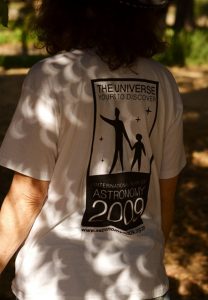The partial solar eclipse on 2017 February 26 was a spectacular event. Photographs taken by ASSA members and others appear below, followed by the original announcement page. Please submit your images to the Shallow Sky Section.
Photo gallery
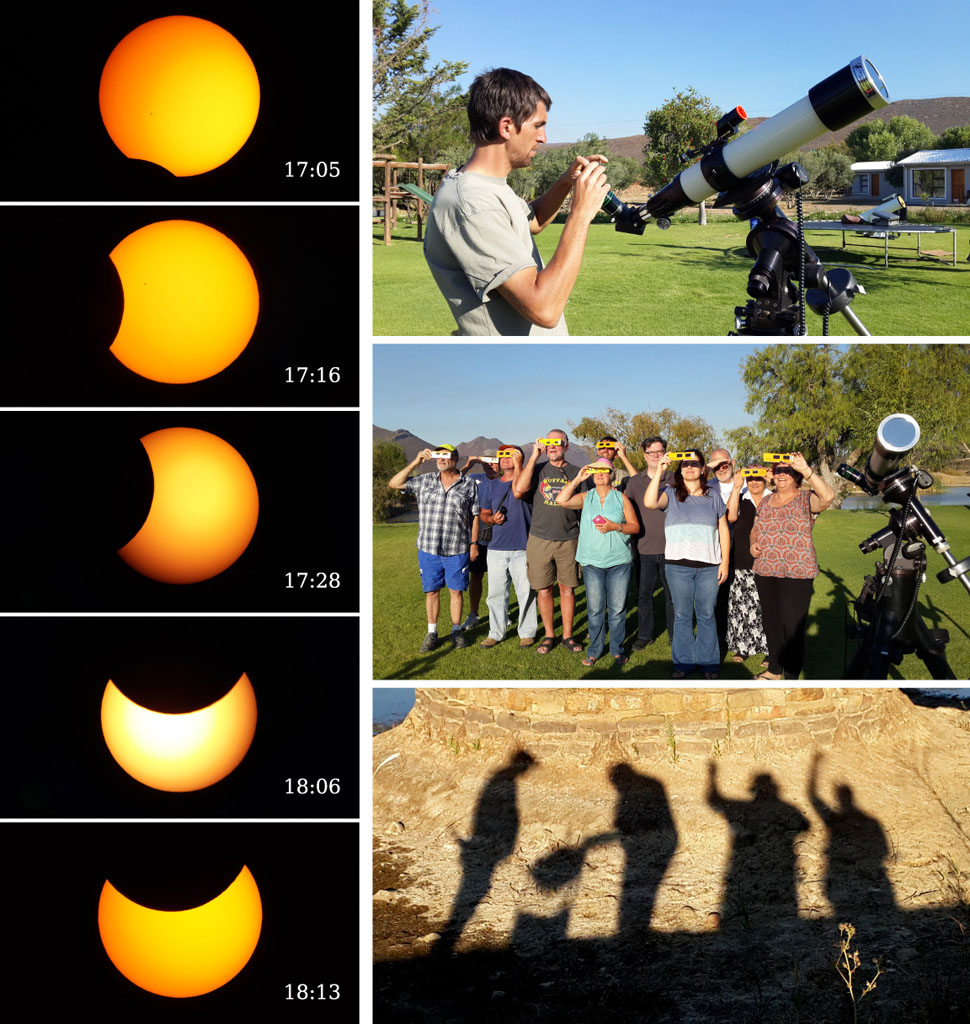
(above) Seen from the 13th Southern Star Party at Leeuwenboschfontein in the Klein Karoo. More images on Auke Slotegraaf’s website.
Original page
What will I see?
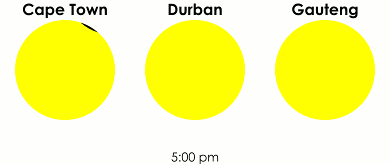 A solar eclipse is a rare opportunity to see the solar system in action.
A solar eclipse is a rare opportunity to see the solar system in action.
For a short time, the Moon will pass between us and the Sun, and instead of seeing the Sun as a round disc, it will have a “bite” out of it. This “bite” is the Moon, and the size of the “bite” changes as the Moon slowly moves along in its orbit.
From where can I see the eclipse?
This eclipse is visible from south-western Africa. If you are anywhere within the shaded region shown on the map, you will see it. The closer you are to the thin darker “centre line”, the deeper and longer your eclipse. If you are lucky enough to be somewhere on the centre line, you will get to enjoy an annular “ring of fire” eclipse!
For more detailed predictions, visit the Moonshadow Mix website, which has details for the 40 African countries that see the eclipse.
Find an eclipse event near you
- Soutpansberg Astronomy Club in Louis Trichardt, Contact Kos 079 148 4934. Weather permitting The Club will also be streaming the event live on YouTube from 17:00 (SAST), at https://www.youtube.com/watch?v=8Cs6F11r7m4
- StarPeople are hosting a viewing event at Leeuwenboschfontein, during the 13th Summer Southern Star Party, in the Klein Karoo. Contact Auke 074 100 7237.
- The Hermanus Astronomy Centre in Hermanus and The Hawston Space Cadets will be viewing the partial solar eclipse from Gearing’s Point and Hawston Harbour on Sunday 26th February from 16:45. There will be telescopes with Solar Filters as well as pinhole photography equipment
- Mafikeng, the Physics Department at the North-West University has invited the public to join them on Sunday 26 February. They will be between the Old Science Building (A4), the swimming pool and the soccer institute from 17:00. Solar viewers, a telescope and camera will be on hand. Please check weather conditions before going out.
- Senekal, the public is invited to the De Rust Church to view the eclipe, for futher information call 082 921 4304
When do I look?
The eclipse is late Sunday afternoon, 2017 February 26.
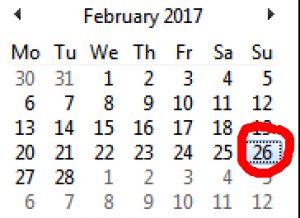 The Moon will take roughly two hours to move across the Sun, and the exact time when it is best to look depends on where on Earth you are. Roughly speaking, around 6pm SAST is maximum eclipse for Southern Africa. But it’s a lot of fun to watch as the eclipse progresses. At first, only a tiny bit of the Sun is eclipsed. Then, as the Moon moves along in its orbit, more of the Sun is covered. Depending on where you are, a greater or lesser proportion of the Sun will be covered. Eventually, the Moon moves away and the Sun is completey uncovered again, although for eastern southern Africa, this will happen after the Sun has set.
The Moon will take roughly two hours to move across the Sun, and the exact time when it is best to look depends on where on Earth you are. Roughly speaking, around 6pm SAST is maximum eclipse for Southern Africa. But it’s a lot of fun to watch as the eclipse progresses. At first, only a tiny bit of the Sun is eclipsed. Then, as the Moon moves along in its orbit, more of the Sun is covered. Depending on where you are, a greater or lesser proportion of the Sun will be covered. Eventually, the Moon moves away and the Sun is completey uncovered again, although for eastern southern Africa, this will happen after the Sun has set.
The table below gives the start, maximum and end times of the eclipse, in local time, for selected places across Southern Africa. The last column gives the percentage of the Sun’s diameter that is covered at the time of maximum. For example, from Cape Town, the eclipse starts at 4:58pm and ends at 6:55pm; at most (at 5:59pm) about half (52%) of the Sun’s diameter will be blocked by the Moon.
| Location | Start | Maximum | End | Magnitude |
| Bloemfontein | 17:10 | 18:09 | sunset (18:48) | 57% |
| Bulawayo [SAST] | 17:20 | 18:21 | sunset (18:32) | 75% |
| Carnarvon | 17:05 | 18:05 | 19:00 | 55% |
| Cape Town | 16:58 | 17:59 | 18:55 | 52% |
| Durban | 17:12 | 18:08 | sunset (18:29) | 53% |
| Gaborone [SAST] | 17:14 | 18:15 | sunset (18:46) | 66% |
| Harare [SAST] | 17:23 | sunset | sunset (18:20) | 79% |
| Johannesburg | 17:14 | 18:13 | sunset (18:38) | 62% |
| Lusaka [SAST] | 17:25 | 18:26 | sunset (18:30 | 87% |
| Maputo [SAST] | 17:17 | 18:13 | sunset (18:20) | 61% |
| Windhoek [SAST] | 17:09 | 18:16 | 19:16 | 76% |
How do I look?
The easiest and safest way to follow the eclipse is to use pinhole-projection. All you need is a sharp pencil and two pieces of paper!
Another cool way is to put a piece of white paper on the ground underneath a tree – the gaps between the leaves will pinhole-project the Sun’s image!
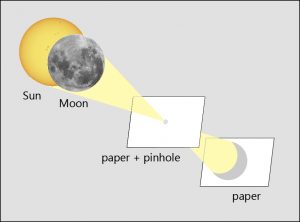
A 2.5min clip on how to watch the eclipse safely without any specialized equipment is available here; more advanced ways of projecting the Sun for indirect viewing are described on the “How To Observe The Sun” page
To view the Sun directly, you need a special filter, such as that in eclipse glasses, to protect your eyes. More advanced methods, including using a telescope with a solar filter, are described on the “How To Observe The Sun” page.
If it is raining, you obviously won’t see anything! If it is cloudy, you may still have a chance. But hopefully, the skies will be clear and the Sun will be shining brightly.
Can I take a Solar Eclipse Selfie?
Yes, you can!
The safest, easiest and most interesting way to do this is to photograph the projected Sun.
Having writing on the surface you’re projecting on (e.g. sheet of paper, T-shirt) helps the camera to focus. And don’t forget to turn off the flash!
The accompanying photo, taken by Simon Fishley during the 2009 eclipse, is a good example because it was taken in the dark shade under a tree, so the pinhole-projected Sun is bright.
It’s not a good idea to point your camera directly at the Sun, even through eclipse viewers – you risk damaging your eyes aiming the camera, and the photos are generally tiny and disappointing.
For detailed advice check out our How to Photograph a Solar Eclipse page.
Sharing is Caring!
On Facebook: Share your photos on the ASSA facebook page [ https://www.facebook.com/Astrosocsa/ ].
On Twitter: Post your photo with the hashtag #eclipse and tag @AstroSocSA in your tweet.
Selected images will be added to the ASSA image gallery.
Preparing for the eclipse
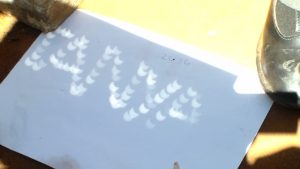
A few days before the eclipse, check that you’ve got everything you need. Do a test run by projecting the Sun and see that you get a nice sharp round image. Now take some photos and experiment with different positions and settings.
Think about where you will be on the afternoon of the eclipse, and if the venue is suitable (e.g. safe, accessible, clear view of the Sun, a suitable tree for pinhole projection, etc.). If possible, do a test run, too, with all the equipment and materials you’ll need.
What, exactly, is an eclipse?

A solar eclipse occurs when the Moon blocks sunlight that normally falls on the Earth. (During a lunar eclipse, the Earth’s shadow falls on the Moon.) A solar eclipse can only occur at the time of New Moon. Because the plane of the Moon’s orbit is tilted slightly, in most months the Sun–Moon–Earth alignment is not exact and the Moon’s shadow misses the Earth. When the alignment is correct, the Sun is eclipsed! If the alignment is exact, then the eclipse is either total or annular (ring-shaped), depending on the distance to the Moon. If the alignment is good but not perfect, then a partial eclipse is seen.
In a calendar year, between four and seven eclipses (solar and lunar combined) can occur; at least two and at most five will be eclipses of the Sun. From any given location, there will be, on average, a partial eclipse every couple of years and a total solar eclipse once in 375 years.
The next total solar eclipse visible in southern Africa will be in 2030. The next partial solar eclipse visible from southern Africa is early in the morning of 2020 June 21.
The next lunar eclipse is on August 7 2017 (from 19:24 to 21:19 SAST). However, the Moon passes through the edge of the Earth’s shadow, so this will be a partial (25%) eclipse.



